Culture eats strategy for breakfast.
—Peter Drucker
An HR Playbook for a Successful SAFe Implementation
By Lori Priller and Mark Richards
Note: This article is part of the Community Contributions series, which provides additional points of view and guidance based on the experiences and opinions of the extended SAFe community of experts.
Introduction
As an organization builds momentum for a SAFe implementation, it quickly becomes apparent that significant change is involved. Without due attention, this awareness of looming change breeds fear and uncertainty on the part of those affected by the change. That can be most every employee. In any change program, especially one this extensive, the enterprises Human Resources organization has a significant role to play in enabling successful navigation of this journey. But all too often they are engaged late and, sometimes, reluctantly.
In practice, the SAFe implementation coach—or Lean-Agile Center of Excellence—typically first meets the HR part of the organization 4-6 months into an implementation. At that time they come into contact with HR professionals who would very much like to help, but typically lack understanding and the knowledge needed to know how their skills and services fit into the Agile context. The question is, what role do they play in such a transformation, and how do they play it? In this article, we’ll describe an ‘HR Playbook’ to help HR professionals participate in—and indeed help lead—the enterprise on this crucial journey to enhanced business outcomes.
A Roadmap to Follow
In recent years, SAFe has prescribed the steps most enterprises use to succeed on their journey in the form of the SAFe Implementation Roadmap. In the remainder of this article, we’ll use the lens of the implementation phases to articulate the changing role and focus of the HR agent as the journey proceeds.
Reaching the Tipping Point, Train Lean-Agile Change Agents, Executives, Managers, and Leaders
“It’s easy for people to keep their old behavior – unless there is an exceptionally good reason to make such a change. A reason so compelling that the status quo becomes simply unacceptable. A reason so strong that change becomes the only reasonable way forward to success.”
(—Scaled Agile Framework Article: Reaching the Tipping Point).
As described in the SAFe Roadmap article, the roadmap provides a series of logical steps that can be used to successfully implement SAFe. As illustrate in Figure 1, the first two steps are Train Lean-Agile Change Agents and Train Executives, Managers and Leaders.
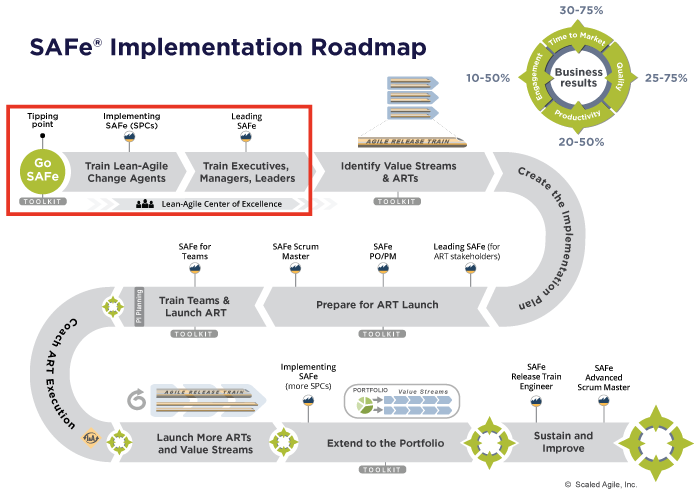
The ‘tipping point’ activities and training of Lean-Agile Change Agents activities happen largely in parallel with all activities leading to the pivotal moments of the training of Executives, Managers and Leaders in the SAFe way of working.
Lean-Agile Change Agents will typically be a blend of internal staff being up-skilled and external consultants brought in to supplement an internal capability. As a collective, they are brought together under the banner of a Lean-Agile Center of Excellence (LACE).
The two primary activities occurring in the tipping point phase are “establishing the need for change”, and “establishing the vision for change”. The HR organization has a critical role to play in both, particularly since the ability to attract and retain the right talent is often a key component of the need for change.
This stage logically leads to the training of the leaders in Leading SAFe– where the group of executives, critical to enabling successful implementation, gain the knowledge of the framework necessary to understand both the organizational implications and key success patterns and endorse progress in the implementation. Considerable focus is required to identify the appropriate representative executive group and gain their commitment to attending this training.
From the perspective of the HR agent, the following are areas of opportunity and needed contribution:
- Articulate the business value goal. There will be a significant HR-driven economic impact, from both the cost of training and enablement perspective and from the potential savings from a flatter organizational model and more effective program execution.
- Baseline employee engagement. If the current approach is annual, consider the implementation of engagement survey tools that can be used on a more frequent basis to enable fast feedback.
- Identify and articulate HR implications and opportunities inherent in the change, and promote your HR change management service offerings to the emerging transformation capability.
- Take the training yourself.
- Ensure HR representatives participate in the training of Lean-Agile Change Agents.
- Ensure HR are effectively represented in the establishment of the Lean-Agile Centre of Excellence (LACE).
- Ensure effective organizational change management knowledge is embedded in the LACE strategy.
Identify Value Streams and ARTs, and Create the Implementation Plan
With a sense of urgency and a powerful coalition in place, it’s now time to implement SAFe.
(—Scaled Agile Framework Article:—Identify Value Streams and ARTs).
The next steps on the SAFe Implementation roadmap are ‘Identify Value Streams and ARTs’, and ‘Create the Implementation Plan’, as illustrated in Figure 2.
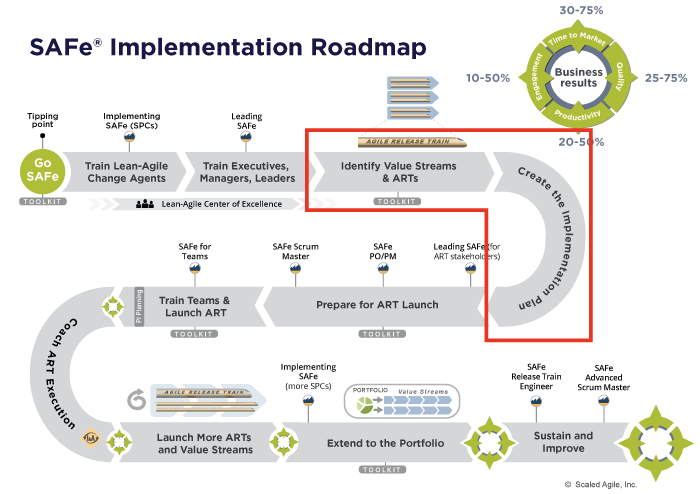
During these phases, initial implementation design and rollout planning are the key activities. When modeling the organization’s value streams, the HR Agent’s knowledge of the organization’s structure and people is a critical enabler. Likewise, considerable organizational change activities are required during the identification of candidates for critical ART roles.
Typical HR agent activities that would commence here include:
- Support an understanding of the new organizational model, one that is optimized to facilitate the flow of value across functional silos, activities, and boundaries.
- Alleviate pain from typical obstacles such as:
- Formal structures that make it difficult for employees to act.
- A lack of needed skills.
- Personnel or information systems.
- Employees who discourage actions toward implementing the new vision.
- Alleviate pain from typical obstacles such as:
- Support employees through major organizational changes. Activities may include serving as a point of contact for questions and concerns and by explaining any impact on staffing.
- Guide the organizational understanding/language/norms at a process, job, people and skill levels.
- Create new job descriptions with the necessary roles and responsibilities.
- Guide workforce planning
Prepare for ART Launch, Train Teams and Launch the ART
From a change management perspective, the first ART is very important, with potentially far-reaching implications. This will be the first material change to the way of working and will generate the initial short-term wins that help the enterprise build momentum.
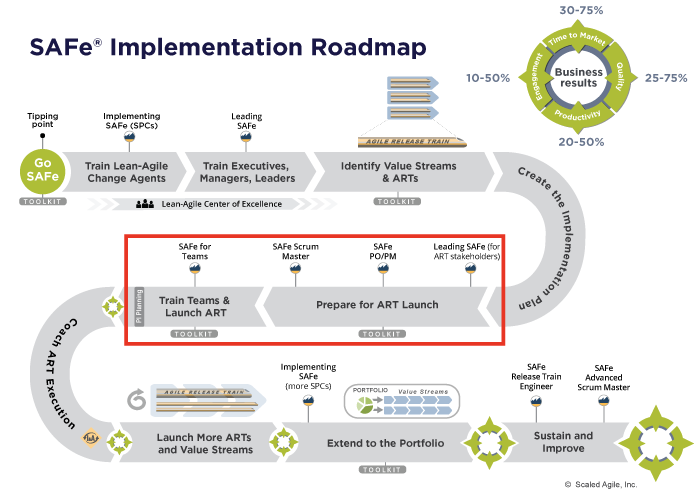
As referred in Figure 3, once the first ART for the implementation is selected, preparation and launch will typically proceed across an 8-10 week period. A range of activities is in-flight, including:
- Identification of candidate members for both lead and team level roles in the ART
- Gradual onboarding of ART members, with a sharp spike in onboarding activity as the launch week nears.
- Scheduling and delivery of the appropriate role-based training, ensuring the appropriate attendees are engaged to attend enablement training, with a specific focus on:
- Leadership Training
- Product Owner/Product Manager training
- ScrumMaster training
- Team training
- Organization of facilities, both for the launch week events and staff seating during execution.
- Preparation of content for the Feature Backlog.
The launch process often culminates with the “1-week quickstart”, the signature event that moves the program from “planning to work differently” to “working together differently”. Every member of the ART will be present for the first two days of training and shared identity formation. Then the crowd will grow to include stakeholders, delivery partners and subject matter experts for the two days of PI Planning. This is the event where a flag is firmly planted in the ground signaling a public beginning to a new way of working. Much of effective preparation is centered upon making the largest possible change impact with the investment in the launch week.
While the value the HR agent can add during these phases should be self-evident, below are some specific recommendations.
- Ensure the employees have access to the experience, skills, and competencies needed to execute the strategy.
- Help employees navigate to new roles and responsibilities.
- Work with management to address gaps in current staffing and future staffing needs through recruitment, training and development, contingent staffing, and outsourcing.
- Observe and mentor employees level of readiness. We notice there are six states of change readiness: indifference, rejection, doubt, neutrality, experimentation, and commitment. Utilize SAFe Metrics to establish a baseline.
- Work with functional management to help them understand the impact of new ways of working on their functional management responsibilities.
- Develop methods for anchoring changes to the organizational culture.
Coach ART Execution, Launch More ARTs and Value Streams
“The first ART creates an effective pattern, and the initial ‘institutional muscle memory’ needed to implement additional ARTs in the Value Stream.”
–Launch more ARTs and Value Streams
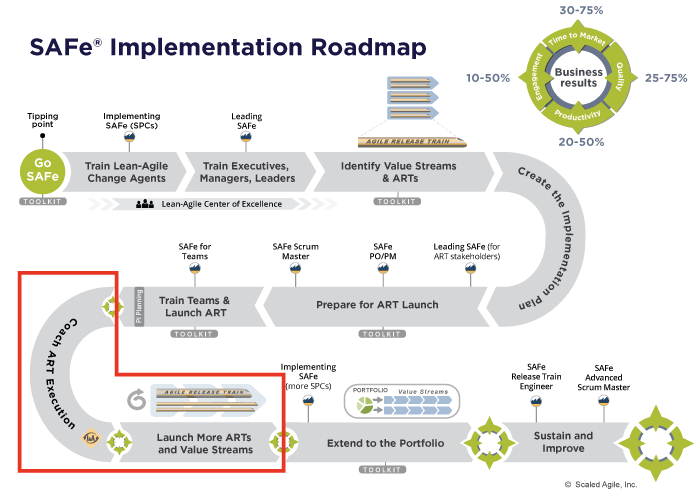
While it is critical to support the ART members through the first steps they take in a new way of working, the early journey of the ART generates a rich learning ground in terms of identifying potential “pain-point patterns” and techniques for adapting SAFe to the organizational context.
From a centralized, or LACE perspective it is critical to harvest learnings from the initial ART(s) in providing higher momentum ‘at-launch’ to subsequent ARTs. These learnings may range from overall ART design to staffing lead time challenges or HR impacts from operating under what is almost inevitably a matrix model in SAFe.
Key areas of focus for the HR professional are:
- Generating short terms wins and making them visible.
- Observe and respond to the connections between new behaviors and organizational success.
- Encourage silo or functional groups to seek an understanding of their current portfolio solutions value stream key performance indicators (KPIs).
- Challenge others in HR to consolidate gains by hiring, promoting and developing employees who can implement the transformation vision.
- Progressive formalization of SAFe or Agile specific roles in the organizational job classification schema.
- Evolving onboarding processes, and developing structure and strategy for ongoing training needs as both additional ARTs are launched and changes in role/membership of existing ARTs occurs.
- As part of the LACE, support the effective evolution of cross-ART learning cycles.
Extend to the Portfolio, Sustain and Improve
This is a telling phase in the rollout as it tests the authenticity of the organization’s commitment to transforming the business at all levels
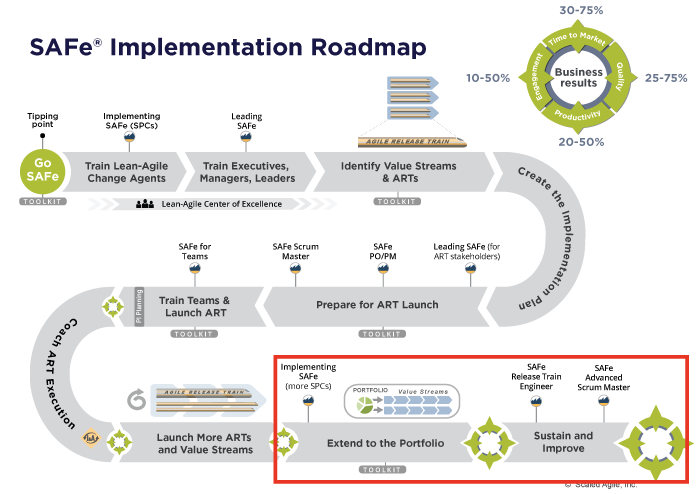
As with many other phases in the implementation roadmap, there is significant synergy and overlap from a timing perspective in these final two steps. Typically, the portfolio level journey in SAFe begins when there are at least three ARTs in flight. The portfolio level changes slowly, as these changes reach deep into the organization’s way of working in key areas such as governance, funding, strategy and performance management.
While the application of the full SAFe Portfolio activities may take some time to achieve, it is vital in the short term that the launched ARTs continue to succeed: which is the focus of Sustain and Improve(see Figure 5).
The HR agent has a rich field of opportunity during this phase, with activities that include:
- Elicit discussion at the portfolio level regarding the current state of principles, practices, and roles needed to initiate and govern a set of new value streams.
- Guide leaders in developing strategies for dealing with change resistance.
- Monitor employee happiness. Look for ways to help them adapt and thrive during change.
- Incorporate team performance in employee evaluation.
- Move to iterative performance feedback. Eliminate annual employee reviews and individual performance incentives.
- Implement reward systems that require cooperation and unity of achievement.
- Structure systems that reward desired behaviors and outcomes with both tangible and intangible rewards.
- Promote feedback from those in the value stream as well as from subject-matter expert consultants.
- Guide managers in developing career paths for their employees.
- Identify strategies for maturing the organization’s internal Lean Change Agents in pursuit of self-sustaining momentum.
Conclusion
Achieving successful SAFe implementations requires transforming people’s ways of working. The HR organization is pivotal to assisting both the navigation of the journey and the sustainability of the result.
All too often, the SAFe implementation coaches are unaware of the potential of the HR organization to enable successful change and unsure of how and when to engage them. Likewise, for the HR specialist, the new language and practices can make it difficult to understand where and how to engage. In this paper, we endeavored to inform the SAFe coach of the manner in which HR specialists can support the implementation, and how to help HR specialists time and focus their contributions – navigating both the language of SAFe and that of the HR world.
For the HR specialist, your journey begins by gaining an understanding of the journey to come, then helping your people to navigate it. At the heart of agile thinking is “learning by doing”, and participation in the early journey will build rich insights as you formulate strategies for an evolution to a flatter organization, the introduction of career paths for SAFe roles, iterative performance reviews and team-based, rather than individual, reward systems.
Our closing suggestion to the SAFe expert is simple: engage HR early and often, and build awareness of both the insights and support they can offer to enable success.
Last update: 25 April 2018


